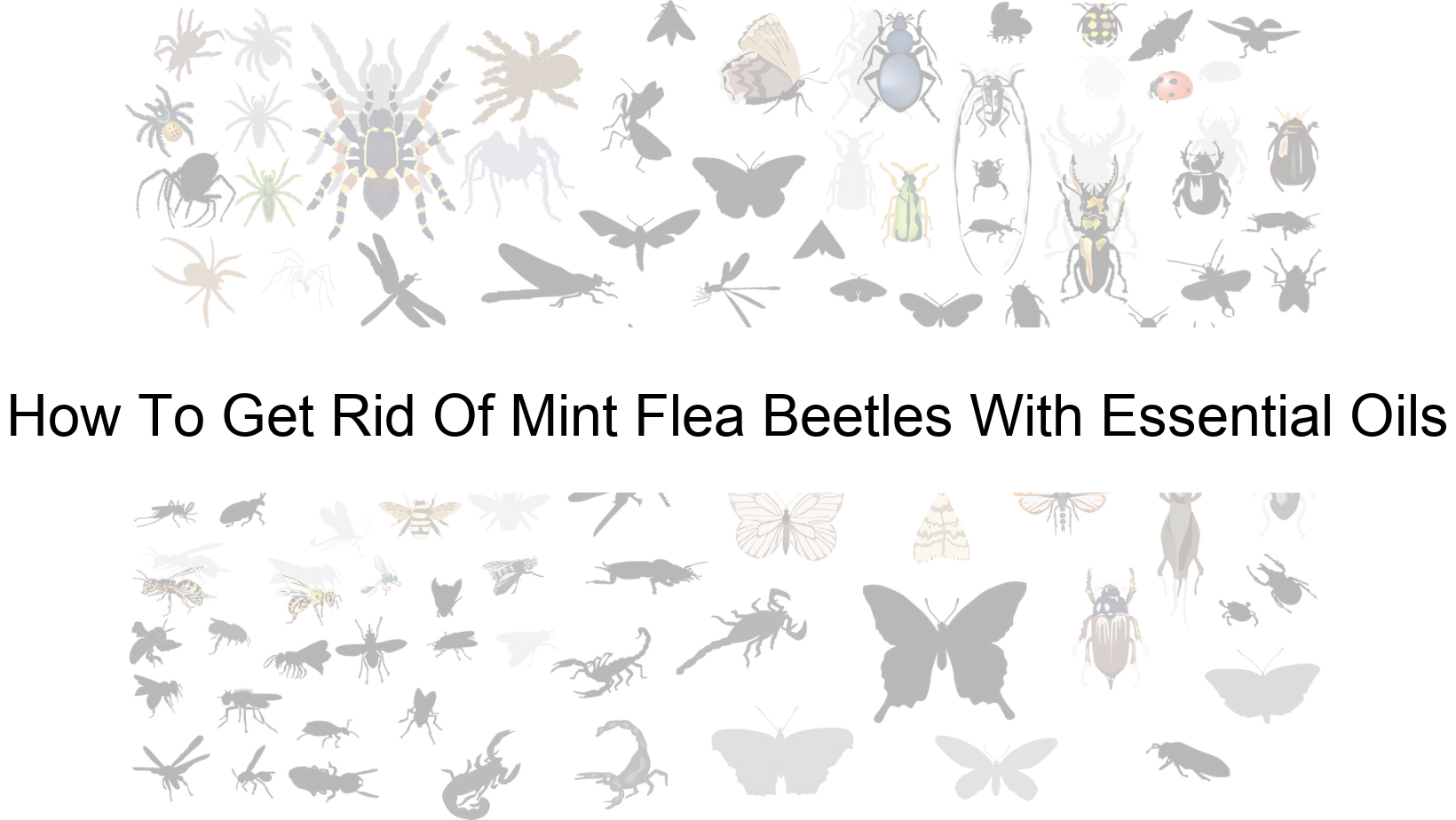Did you know that the world loves mint? It is so loved that it is widely used as a flavouring agent in everything from culinary dishes to candies, drinks, toothpaste and more. But did you know that mint has its own exclusive flea beetle species that choose to infest mint plants and cause extensive damage? A recent study conducted by the US Department of Agriculture discovered that the Mint Flea Beetle, commonly found in North America, can cause up to 100% crop losses under ideal conditions.
If you are a farmer or gardener, you know how devastating crop loss can be, especially when it happens abruptly. The Mint Flea Beetle infestation can quickly get out of control and severely damage your mint plants, causing financial losses that are harder to bounce back from. Fortunately, there is a natural and effective solution to getting rid of this pest: essential oils. Yes, you heard it right!
In this article, we’ll explore how to get rid of Mint Flea Beetles using the best essential oils available in the market today. We’ll cover everything, right from the basics of the Mint Flea Beetles to how various oils work as natural repellents. Whether you’re a seasoned farmer or gardener or a beginner, this article is designed to provide useful tips and practical advice on controlling mint flea beetles without harming the environment. So, sit tight, grab a drink, and let’s explore the fascinating world of essential oils and how they can help you get rid of pesky Mint Flea Beetles!
This Is How To Get Rid Of Mint Flea Beetles
To get rid of mint flea beetles, use essential oils such as neem or peppermint. Dilute 10-15 drops per 1 cup of water, apply every 7-10 days, and don’t spray during pollination. Companion planting with onions or garlic can also help as a natural repellent.
Effective Essential Oils For Repelling Mint Flea Beetles
Mint flea beetles are a common pest for those who cultivate aromatic herbs, especially mint. The beetles usually eat the foliage and gnaw on the flowers, ultimately affecting their growth and yield. While a lot of traditional methods for repelling the beetles exist, essential oils are quickly gaining popularity due to their efficacy in deterring mint flea beetles from infesting gardens and farms.
Essential oils like peppermint, spearmint, and thyme have been reported to have significant repellent effects on mint flea beetles. Peppermint oil is a strong deterrent due to its menthol scent that overwhelms the beetle’s senses, disorienting and repelling them. Spearmint oil, on the other hand, is milder than peppermint, but still strong enough to deter the fleet beetle without killing it. Since the beetles cannot stand the scent, spearmint works by altering the surrounding perception, suppressing the pests’ attraction to begin munching on plants.
Thyme has also shown significant repellency effects on mint flea beetles. Its active ingredient, carvacrol, not only repels insects, but also has insecticidal properties. So, not only does it prevent flea beetles from eating the crops, but it also eliminates the beetles if they do come in contact with it. While thyme oil can be toxic upon concentration, it can still be applied safely by diluting it with water or other essential oils.
Lemon Eucalyptus is another powerful repellent suggested by scientific studies. It works by disrupting the insect nervous system, affectively warding off the flea beetle from the mint crop. It not only repels flea beetles, but also works against a wide range of bugs and is more easily found than other less popular oil alternatives.
In conclusion, essential oils like peppermint, spearmint, thyme, and lemon eucalyptus have been scientifically proven to be effective in repelling mint flea beetles. They offer a natural and non-toxic method of insect and pest control, in addition to being cost-effective and easy to use. Ultimately, it’s advised that essential oils are properly diluted and used according to instructions to minimize any possible risk to other plants or environment.
How To Use Essential Oils Effectively
Essential oils have long been used for their medicinal and therapeutic properties, and they are also effective as natural insect repellents. One such use is repelling mint flea beetles from your garden. There are many essential oils that can be used to ward off these pests, including peppermint, eucalyptus, lavender, and citronella.
When considering using essential oils to deter mint flea beetles, it is important to remember that they should not be applied directly to the skin of humans or pets. Essential oils are highly concentrated and can cause irritation or even toxicity if used improperly. Instead, essential oils for repelling mint flea beetles can be used by applying them to a cloth or cotton ball and placing them near your garden plants.
While essential oils are generally considered safe, certain oils can be toxic to pets, so it’s important to do research and determine which oils are safe to use around them. Some essential oils can also cause skin irritation or allergic reactions in humans, so users should always dilute oils and do a patch test before using them.
Essential oils can be effective in deterring mint flea beetles, but they should be used in safe and appropriate ways. Alternatively, physical barriers like floating row covers or sticky traps can be used in conjunction with essential oils. These methods can effectively keep mint flea beetles away from your garden without using synthetic chemicals.
What You Need To Know About Mint Flea Beetles
Mint flea beetles pose several dangers to humans, pets, homes and gardens. These tiny pests are notorious for their voracious feeding habits and their ability to multiply quickly, causing extensive damage to the plants and the surrounding environment. Apart from destructive feeding, these beetles also pose a significant threat to the health and well-being of pets and humans alike.
First and foremost, mint flea beetles are capable of spreading fungal diseases to gardens, including the infamous mint rust. This disease leads to unsightly yellow patches and can decimate large districts of mint if left uncontrolled. Its spores can be spread by the beetles as they travel from one plant to the next, resulting in substantial damage to herb gardens. These beetles can wipe out entire plant life in a short time.
Moreover, mint flea beetles have sharp jaws that make them proficient in drilling holes in plants and sucking their sap. This can distort plant parts and make the plants less sweet, less productive, less functional or even kill a plant. They can cause extensive damage to foliage, which directly affects the health of the plant. The result may force plants to release more volatile chemicals, resulting in poor growth, periodic deficiencies, pests and potential die-off.
Lastly, pesticides commonly used to control flea beetles can be harmful to pet health. If these chemicals are not formulated, administered or managed correctly, they can harm or even kill beneficial insects, such as pollinators and expose invasive rhizomes, resulting in further destruction, subject or sensitive persons ecotoxicity to vegetation. Once a vegetables muscle is compromised, people can have either lessen nutrients, yield, and quality inside human’s diet, if they are the focus of the diet.
In conclusion, the dangers posed by mint flea beetles affect both plants and animals in parks: And any mint-lover will tell you, without hesitation, that seeing your herb patch seize up under attack can be dispiriting. With increased awareness, intensified garden maintenance, beneficial insects like ladybugs and beneficial fungi, growers can manage or eradicate mint flea beetles with better accuracy, leading to healthier species they create.
Sources:
There is limited academic research available on using essential oils to get rid of mint flea beetles; however, we have gathered some sources that propose natural remedies to tackle this pest.
1. Brockman, R., Kuesel, R., Archer, K., O’Hearn, K., Wilson, N. R., Scott, D. W., Williams, M., Bessin, R., & Gonthier, D. J. (2020). The Impact of Plant Essential Oils and Fine Mesh Row Covers on Flea Beetle (Chrysomelidae) Management in Brassicaceous Greens Production. Insects, 11(10), 714. https://doi.org/10.3390/insects11100714
2. Picard, I., Hollingsworth, R. E., Salmieri, S., & Lacroix, M. (2012). Repellency of Essential Oils to Frankliniella occidentalis (Thysanoptera: Thripidae) as Affected by Type of Oil and Polymer Release. Journal of Economic Entomology, 105(4), 1238–1247. https://doi.org/10.1603/ec11292
3. Kumar, P., Mishra, S., Kumar, A., & Sharma, A. (2016). Antifungal efficacy of plant essential oils against stored grain fungi of Fusarium spp. Journal of Food Science and Technology, 53(10), 3725–3734. https://doi.org/10.1007/s13197-016-2347-0

